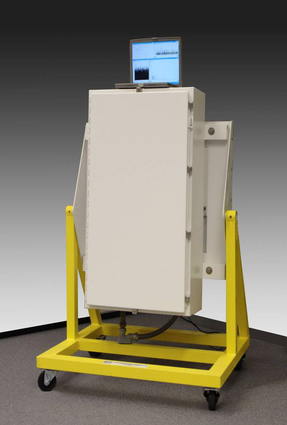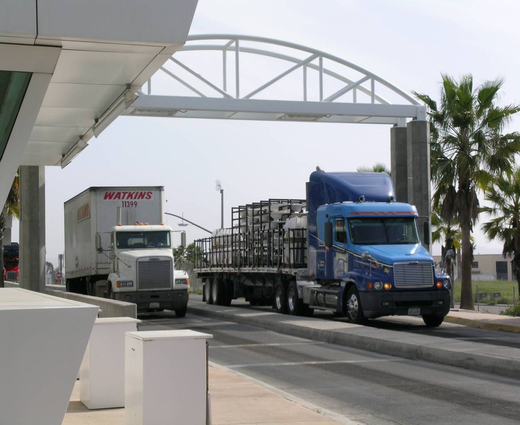States use LLNL-developed radiation detection advance for highway monitors, patrolling roads
LIVERMORE -- A radiation detection technology developed by Lawrence Livermore National Laboratory (LLNL) scientists is being employed by state and local governments to monitor for nuclear materials that could be part of a "dirty bomb" or nuclear device.
The radiation detection advance has been licensed to – and converted into counterterrorism tools – by Textron Defense Systems Corp., a firm headquartered in Wilmington, Mass.
So far, one state in the Western United States has deployed more than a score of the radiation detectors, called the adaptable radiation area monitor (ARAM), and placed them at vehicular entrances to that state to monitor for nuclear materials. The ARAM systems can detect concealed radioactive material about the size of a grain of sand moving at 45 miles per hour, nearly freeway speed.
A second state, New Jersey, has acquired from Textron Defense Systems a fleet of SUV’s outfitted with the ARAM detection technology to patrol its highways and streets for nuclear materials.
Recently, the U.S. Department of Homeland Security (DHS) announced that it is providing grants through its Securing the Cities initiative to enhance regional capabilities to detect and interdict illicit radioactive materials.
The New Jersey SUVs, known as RadTrucks, have been in operation for more than a year, as the Garden State joined multiple agencies in the New York City region in a federal pilot program that aims to detect terrorist nuclear material before it can be detonated. The prototype for the RadTruck, developed by LLNL, was first fielded in the New York/New Jersey region and was used by DHS and NY/NJ authorities during the 2004 Republican National Convention.
The New Jersey Office of Homeland Security and Preparedness, in concert with the New Jersey State Police, have collaborated in the acquisition and utilization of these detection assets. These agencies have cooperatively addressed the use of the RadTrucks for everyday patrols, as well as for the vital role they are expected to play in the event of emergent circumstances, said Capt. Dennis McNulty, the chief of the Transportation Safety Bureau for the New Jersey State Police.
New Jersey’s RadTrucks are remarkably simple to use, said state Trooper Dave Gatto, who was quoted in a Philadelphia Inquirer article. Gatto said that after 10 hours of training he could tell the difference between the radioactive signatures emitted by uranium, cesium, and plutonium and even mundane sources such as kitty litter.
In addition to New Jersey, a second state has purchased RadTrucks and other states have expressed interest in acquiring units, said Brian Adlawan, program director for detection systems for Textron Defense Systems.
"This isn’t only a technology that’s been licensed," Adlawan said. "It’s been turned into products and is on the market for federal, state and local agencies to use to help protect against terrorism."
One advantage of the technology, according to Adlawan, is that it can be rapidly redeployed based on intelligence and new developments. Another bonus is that the technology allows state agencies to continue their normal law enforcement functions, along with monitoring for nuclear materials.
Developed by a team of LLNL scientists and engineers, the versatile ARAM detection system was designed to be an all-purpose monitor or "everyman’s tool" for spotting nuclear materials. The ARAM inventors have received two patents and in 2005 won a R&D 100 award as one of the top industrial inventions in the world.
ARAM can be deployed in a host of ways – as a portable detector in an SUV, as a vehicle monitor alongside freeways, as a pedestrian portal monitor, as a package or luggage detector, as a fixed maritime detector and as a portable maritime detector.
Operating at room temperatures, ARAM can detect gamma rays and, with the assistance of a helium-3 neutron detector, also can monitor for neutrons.
The system relies on a minimum number of components, including a sodium iodide detector, multi-channel analyzer, computer and sophisticated LLNL control and commercial analysis software. It acquires 1,024 channels of data 10 times per second, which allows the control software a higher probability of detection and provides the commercial analysis software with highest quality data for identification.
"This type of system gives us a better chance of not only picking up that there’s radiation, but the type of radiation, whether it’s a medical isotope or a terrorist device," said Dave Trombino, a nuclear engineer at LLNL and one of the ARAM developers.
"The technological breakthrough of this system is buried in the software, which controls the data collection and analysis," Trombino said. "One of Livermore’s strengths is world-class signal processing capabilities and we relied on those skills to write our own software to be able to perform our own analysis.
"The ARAM technology has demonstrated its effectiveness through its use by various state agencies. The ‘A’ in ARAM stands for adaptable, and this technology has proven that to be the case as it has used in trucks, placed it along highways and now is being looked at for maritime applications," Trombino added.
Some of the other radiation detection technologies developed by LLNL researchers that have been licensed and turned into products are "The Detective" and the "Fission Meter," both licensed to Oak Ridge, Tenn.-based AMETEK’s Advanced Measurement Technology ORTEC Division.
Founded in 1952, Lawrence Livermore National Laboratory is a national security laboratory with a mission to ensure national security and apply science and technology to the important issues of our time. Lawrence Livermore National Laboratory is managed by Lawrence Livermore National Security, LLC for the U.S. Department of Energy's National Nuclear Security Administration.
Textron Systems Corporation (Textron Systems) has been providing solutions to the defense, homeland security and aerospace communities for more than 50 years. Known for its precision smart weapons, intelligent battlefield systems, surveillance systems, intelligence software solutions, aircraft control components, piston engines, armored vehicles and unmanned aircraft systems, Textron Systems includes AAI, HR Textron, Lycoming Engines, Overwatch Tactical Operations Overwatch Geospatial Operations, Textron Defense Systems and Textron Marine and Land Systems. Textron Systems Corporation is an indirect wholly owned subsidiary of Textron Inc. More information is available at www.textronsystems.com/ .
Contact
Steve Wampler[email protected]
925-423-3107
Related Links
Detecting Radiation on the MoveAdaptable Radiation Area Monitor
Berkeley Nucleonics Radiation Portal fact sheet
Textron ARAM datasheet
Textron Systems' Adaptable Radiation Area Monitor Designated as a Qualified Anti-Terrorism Technology







